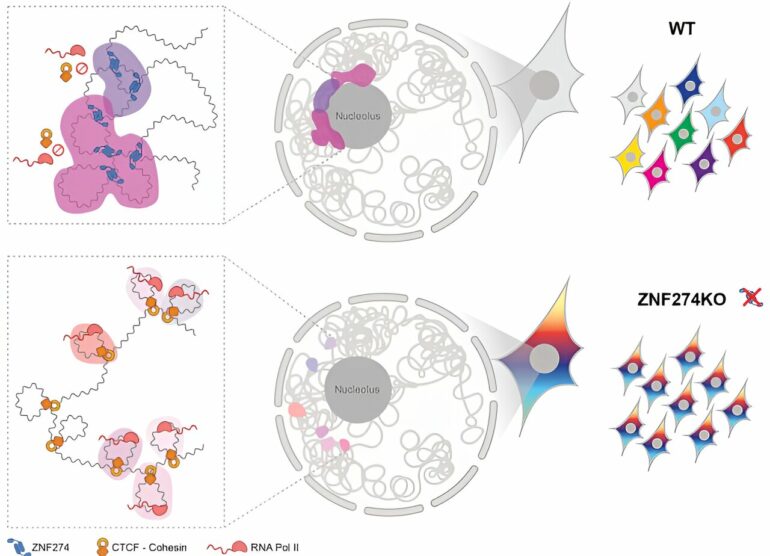In a discovery that sheds light on the complex mechanisms of gene regulation, scientists at EPFL have uncovered a critical role for the protein ZNF274 in keeping certain gene clusters turned off by anchoring them to the cell nucleolus. The study is published in Science Advances.
Our DNA is not just a string of genes; it’s a complex and dynamic structure where the spatial organization within the nucleus plays a crucial role in regulating which genes are turned on or off. One key player in this intricate process is the nucleolus, a spherical structure that sits inside the cell’s nucleus, the compartment where gene expression is orchestrated and performed.
The nucleolus is primarily known as the site of production of ribosomes, which play key roles in the making of proteins. However, recent studies have found that the nucleolus is also involved in regulating gene expression.
Controlling gene activity
The nucleolus is surrounded by regions of the genome called nucleolus-associated domains (NADs), which host repressed—or “silenced”—genes. Scientists think that NADs play a key role in maintaining under tight control genes arranged in clusters along chromosomes, which is essential for proper cell function and development. However, the mechanisms that target specific gene clusters to NADs have remained largely mysterious.
Understanding how genes are repressed in these compartments is critical not just for basic biology but also for understanding diseases where gene repression goes wrong. For example, improper regulation of gene clusters has been implicated in various developmental or psychiatric disorders and cancers.
The protein ZNF274: The boss of silenced genes
A team of scientists at EPFL, led by Martina Begnis and Didier Trono, has now found that a protein called ZNF274 helps control certain groups of genes, including those needed for brain development, by locking them in specific parts of the cell where they stay quiet, ensuring that these genes only turn on when they’re supposed to.
How does ZNF274 do this? By serving as a bridge between NAD components and these gene clusters, which it recognizes because they carry a critical sequence motif. ZNF274 anchors target genes, including those involved in neural development, to NADs, thereby maintaining their repression.
Focusing on the consequences of ZNF274’s absence
The researchers used a combination of CRISPR/Cas9 gene editing and advanced sequencing techniques to create cells that lacked the ZNF274 protein, in which they could study the effects on gene expression and genome organization.
The absence of ZNF274 led to the activation of previously repressed gene clusters, e.g. those encoding protocadherins, which are critical for neural development. They also noticed changes in the structure of chromatin—the complex of DNA and proteins that forms chromosomes—leading to altered 3D genome architecture.
The study found that ZNF274 helps keep certain groups of genes turned off by attaching them to the nucleolus. When ZNF274 is missing, these genes become active when they shouldn’t.
The researchers also found that ZNF274 uses a specific part of it, called the SCAN domain, to contact the nucleolus. This connection keeps the genes in “off” mode, preventing them from being switched on accidentally.
The study has broad implications for our understanding of gene regulation, providing insights into the fundamental processes that ensure the correct expression of genes during development.
It also suggests that disruptions in this system could contribute to developmental disorders and diseases such as schizophrenia and Prader-Willi syndrome, where gene regulation is known to be affected.
More information:
Martina Begnis et al, Clusters of lineage-specific genes are anchored by ZNF274 in repressive perinucleolar compartments, Science Advances (2024). DOI: 10.1126/sciadv.ado1662
Provided by
Ecole Polytechnique Federale de Lausanne
Citation:
How a protein keeps gene clusters quiet in the cell nucleolus (2024, September 27)



